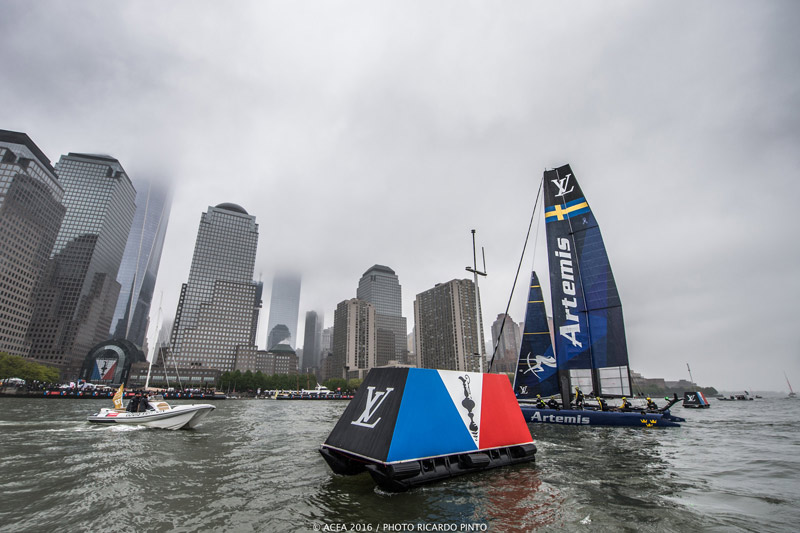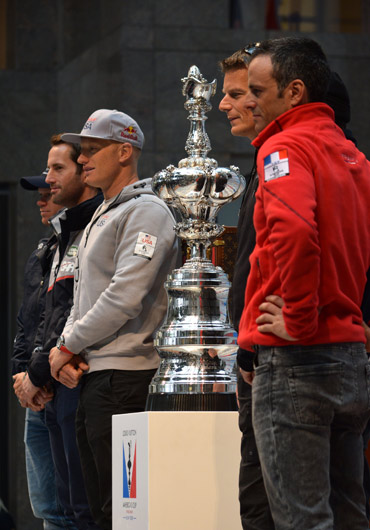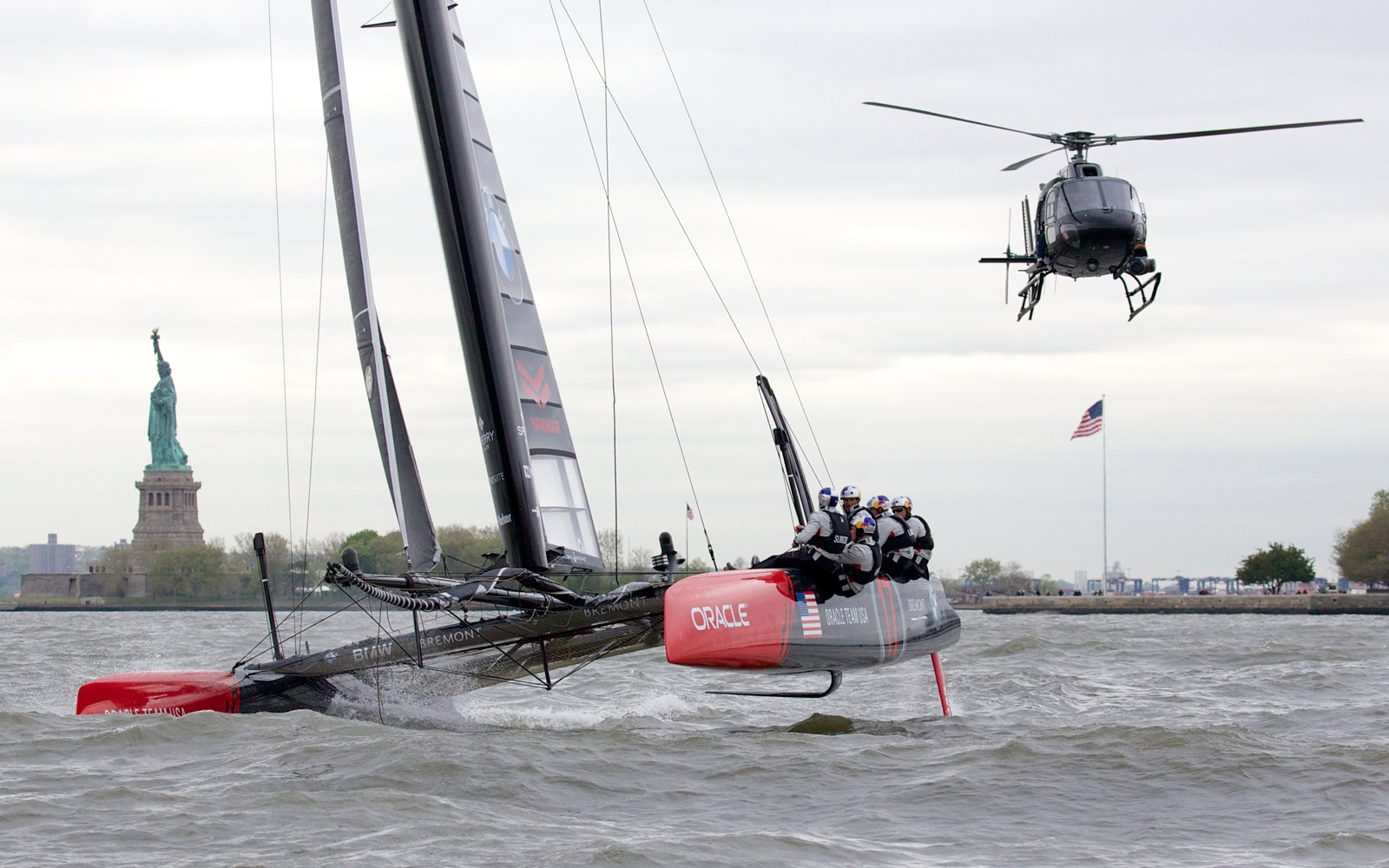|
|
|||||||||
|
America's Cup Returns to New York May 6, 2016 |
|||||||||
|
America’s Cup racing will return to New York City May 7-8 in the form of the Louis Vuitton America’s Cup World Series, a fleet racing event featuring foiling wingsail multihull yachts capable of speeds over 40 miles-per-hour. Unlike the first defense of the America’s Cup held here by the New York Yacht Club in 1870, when the British challenger Cambria faced a fleet of 17 defenders at once, all trying to beat her, the 2016 regatta will see multiple boats, all out for themselves. The winner of the regatta will gain valuable points counted toward the seeding of the challenger selection series for the 35th Defense of the America’s Cup next June in Bermuda. The five teams competing to be the challenger in the 2017 America’s Cup match, SoftBank Team Japan, Land Rover BAR (UK), Artemis Racing (Sweden), Groupama Team France, and Emirates Team New Zealand, will fleet race against each other here along with defender Oracle Team USA. The race area will be between the Battery and Pier 25, shifting to align the course with the wind direction, and keeping the start and finish lines close to North Cove Marina when feasible. The New York venue, though it offers a spectacular backdrop of iconic skyscrapers and the Statue of Liberty, looks to be a difficult proposition on the water for the sailors. The Hudson River has strong currents which interact with the Atlantic Ocean tides. Where the East River joins the Hudson at the tip of Manhattan, local sailors speak of unpredictable and intimidating conditions, further complicated by confused seas created by commercial shipping and ferry wakes, not to mention the action of wind potentially working against tide and current. Another hazard in a larger commercial and urban river is the presence of flotsam and jetsam, floating debris that includes plastic, lumber, and more; this material is readily found in the area of the race course. The damage from striking these materials at speeds from 10 to 40 knots, sailing on hulls or foils, could end a competitor’s chances in the regatta, or even lead to injury, and the skippers will have to remain critically alert for these hazards. Just as much of a wild card, the racing will be up as close to the shore of Battery Park as possible. That will be great for spectators in the free America’s Cup Village located in the Waterfront Plaza at Brookfield Place, just west of the World Trade Center site. But the wind effects from the forest of Manhattan skyscrapers may play havoc with the wind strength and direction. None of the sailors have really raced in this location before, so local knowledge is scarce. The skippers began practicing in NY on Thursday and Friday for just a couple hours each day, though light winds and rain kept the boats sailing on their hulls instead of foils most of the time Friday. Weather forecasts for the weekend, Sunday especially, are improving, with winds WNW 15-20 knots, and gusts higher, being forecast as of Saturday morning. Friday’s practice included a provisional “Substitute Race” to be counted only in case conditions cause a delay in Saturday’s race start. In that case the provisional race will be shown on the international broadcast, and the results will become official. Saturday’s contests will be shown also on regional sports channels, but not broadcast nationally in the US. Sunday’s racing will be televised on NBCSN in the US. Racing coverage is also available online via the AC+ app for Apple or Android devices.
If the schedule permits racing to start later in the day Saturday, any of those races will also be counted. ACWS race organizers have a fixed schedule with the Coast Guard and local authorities to stage the races, though, so they will make every effort to get the races off in the allotted time window. What do the teams get out of this competition other than the honor of a win in the longtime home of the America’s Cup? First, the points earned for all finishing position are counted toward the overall 2015-2016 America’s Cup World Series standings. The winner of that series will start two points ahead in the America’s Cup Qualifiers next May, trying to eliminate the others and challenge Oracle Team USA. The second-place team will start one point ahead. Second, the event is a good opportunity for the crews to train together. Though some aspects of the ACWS aren’t directly applicable to the actual America’s Cup and the challenger selection Qualifier and Playoffs next year -- such as the current fleet racing format versus one-on-one match racing -- the ACWS teams all value the opportunity to gauge their crew work and boathandling against the other sailors. The skippers stress that one of their major tasks at this stage of preparation for 2017 is improving communication on the boat, and building a familiarity with each other and the varied responsibilities of jointly sailing a foiling yacht in a variety of situations. The goal is for the crew’s behavior, their expectations, their actions, and the way they signal their intentions to each other to become intuitive. The high-speed boats perform well in the hands of the young hotshots from the high-performance dinghy and moth classes who have been picked up by the America’s Cup teams, eager to find people with the reaction and balance skills honed in those small boats. This is not trivial. Going from being world-class fast on a solo rocket like the Moth, or two-man flying trapeze act like the 49er, to (eventually) beating the best in the world on a 50-foot foiling cat will require solving that communication problem with six person crew. Many specifics of technique, tuning, and tactics will change after the teams start sailing their single new AC50 yachts early next year, and continue to evolve all the way to the last race, but for now some hot-blooded competition gives them the opportunity to work on functioning well together under stress and to benchmark their progress against the others. In the meantime, crowds in the tens of thousands are expected to watch the racing for free up and down the Manhattan shore, on the water, and from the New Jersey side of the Hudson. It doesn’t take much, even in Friday’s lazy practice session, to see the visual echoes of the early America’s Cup matches that were held nearby in the Narrows and the Lower Harbor, also witnessed by thousands amid the chaos of the excursion boats, the massive private motoryachts, and a certain torch-bearing colossus in the distance. Much has changed, and this event isn’t actually the defense, but for a weekend at least, even if just visiting, the America’s Cup is home. ---From CupInfo.com/©2016 Cupinfo
Links of Interest: |


